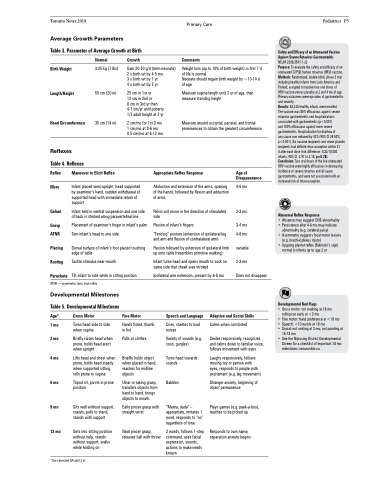Page 1039 - TNFlipTest
P. 1039
Toronto Notes 2019
Primary Care
Pediatrics P5
Average Growth Parameters
Table 3. Parameter of Average Growth at Birth
Safety and Efficacy of an Attenuated Vaccine Against Severe Rotavirus Gastroenteritis
NEJM 2006;354:11-22
Purpose: To evaluate the safety and efficacy of an attenuated G1P[8] human rotavirus (HRV) vaccine. Methods: Randomized, double-blind, phase 3 trial including healthy infants from Latin America and Finland, assigned to receive two oral doses of HRV vaccine versus placebo at 2 and 4 mo of age. Primary outcomes were episodes of gastroenteritis and severity.
Results: 63,225 healthy infants were enrolled. The vaccine was 85% efficacious against severe rotavirus gastroenteritis and hospitalizations associated with gastroenteritis (p<0.001)
and 100% efficacious against more severe gastroenteritis. Hospitalization for diarrhea of
any cause was reduced by 42% (95% CI 29-53%, p<0.001). Six vaccine recipients and seven placebo recipients had definite intussusception within 31
d after each dose (risk difference -0.32/10,000 infants; 95% CI -2.91 to 2.18, p=0.78). Conclusion: Two oral doses of the live attenuated HRV vaccine were highly efficacious in decreasing incidence of severe rotavirus and all-cause gastroenteritis, and were not associated with an increased risk of intussusception.
Abnormal Reflex Response
• Absence may suggest CNS abnormality • Persistence after 4-6 mo may indicate
abnormality (e.g. cerebral palsy)
• Asymmetry suggests focal motor lesions
(e.g. brachial plexus injury)
• Upgoing plantar reflex (Babinski’s sign)
normal in infants up to age 2 yr
Developmental Red Flags
• Gross motor: not walking at 18 mo rolling too early at <3 mo
• Fine motor: hand preference at <18 mo • Speech: <10 words at 18 mo
• Social: not smiling at 3 mo; not pointing at
15-18 mo
• See the Nipissing District Developmental
Screen for a checklist of important 18 mo milestones: www.ndds.ca
Birth Weight
Length/Height
Head Circumference
Reflexes
Table 4. Reflexes
Normal
3.25 kg (7 lbs)
50 cm (20 in)
35 cm (14 in)
Growth
Gain 20-30 g/d (term neonate) 2 x birth wt by 4-5 mo
3 x birth wt by 1 yr
4 x birth wt by 2 yr
25 cm in 1st yr
12 cm in 2nd yr
8 cm in 3rd yr then 4-7 cm/yr until puberty 1/2 adult height at 2 yr
2 cm/mo for 1st 3 mo 1 cm/mo at 3-6 mo 0.5 cm/mo at 6-12 mo
Comments
Weight loss (up to 10% of birth weight) in first 7 d of life is normal
Neonate should regain birth weight by ~10-14 d of age
Measure supine length until 2 yr of age, then measure standing height
Measure around occipital, parietal, and frontal prominences to obtain the greatest circumference
Reflex
Moro
Galant
Grasp ATNR
Placing Rooting Parachute
Maneuver to Elicit Reflex
Infant placed semi-upright, head supported by examiner’s hand, sudden withdrawal of supported head with immediate return of support
Infant held in ventral suspension and one side of back is stroked along paravertebral line
Placement of examiner’s finger in infant’s palm Turn infant’s head to one side
Dorsal surface of infant’s foot placed touching edge of table
Tactile stimulus near mouth
Tilt infant to side while in sitting position
Appropriate Reflex Response
Abduction and extension of the arms, opening of the hands, followed by flexion and adduction of arms
Pelvis will move in the direction of stimulated side
Flexion of infant’s fingers
“Fencing” posture (extension of ipsilateral leg and arm and flexion of contralateral arm)
Flexion followed by extension of ipsilateral limb up onto table (resembles primitive walking)
Infant turns head and opens mouth to suck on same side that cheek was stroked
Ipsilateral arm extension, present by 6-8 mo
Age of Disappearance
4-6 mo
2-3 mo
3-4 mo 4-6 mo
variable
2-3 mo
Does not disappear
ATNR = asymmetric tonic neck reflex
Developmental Milestones
Table 5. Developmental Milestones
Age*
1 mo 2 mo
4 mo
6 mo
9 mo
12 mo
Gross Motor
Turns head side to side when supine
Briefly raises head when prone, holds head erect when upright
Lifts head and chest when prone, holds head steady when supported sitting, rolls prone to supine
Tripod sit, pivots in prone position
Sits well without support, crawls, pulls to stand, stands with support
Gets into sitting position without help, stands without support, walks while holding on
Fine Motor
Hands fisted, thumb in fist
Pulls at clothes
Brieflly holds object when placed in hand, reaches for midline objects
Ulnar or raking grasp, transfers objects from hand to hand, brings objects to mouth
Early pincer grasp with straight wrist
Neat pincer grasp, releases ball with throw
Speech and Language
Cries, startles to loud noises
Variety of sounds (e.g. coos, gurgles)
Turns head towards sounds
Babbles
“Mama, dada” – appropriate, imitates 1 word, responds to “no” regardless of tone
2 words, follows 1-step command, uses facial expression, sounds, actions to make needs known
Adaptive and Social Skills
Calms when comforted
Smiles responsively, recognizes and calms down to familiar voice, follows movement with eyes
Laughs responsively, follows moving toy or person with eyes, responds to people with excitement (e.g. leg movement)
Stranger anxiety, beginning of object permanence
Plays games (e.g. peek-a-boo), reaches to be picked up
Responds to own name, separation anxiety begins
*Use corrected GA until 2 yr


